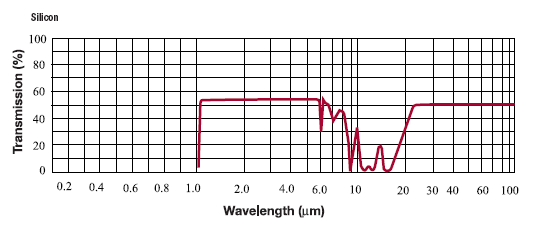![]()

+86 21 51012729
info@bbotech.com
Related link: Silicon Windows and Lenses 
シリコンの特性と伝送曲線
3 ~ 5 µm のスペクトルバンドで動作する赤外線光学系で一般的に使用される半導体材料。屈折率は範囲を通して3.4 の近くにある。また、シリコンは20µm ~ 300 µm の範囲で送信機としても有用である。
シリコンは、熱伝導率、軽量性、硬度のため、レーザー用ミラー基板として使用されています。また、windows と1.2 µm 6.7 µm の範囲内のレンズに使用されます。9µm での吸収が強いため、シリコンは透過光としての co2 レーザーの使用には適していませんが、co2 ミラーに広く使用されています。
シリコンは、一般的な赤外線材料の最も低い密度の1つを持っており、重量制約のあるシステムに最適です。シリコンの密度は、ゲルマニウム、ガリウム砒素、セレン化亜鉛の半分に過ぎません。シリコンはゲルマニウムより硬く、脆いものではありません。シリコンは、すべての赤外線材料の最小材料コストのオプションです。
|
Property |
Specification |
|
Transmission Range |
1.2µm to 7.0µm & from 25µm out to beyond 300µm |
|
Density |
2.329 g/cm3 |
|
Thermal Expansion |
2.55 x 10-6 /°C @ 25°C |
|
Surface Finish |
Typical specifications for surface quality in the infrared are a 40-20 scratch-dig in the 1.2 to 3µm spectral region & 60-40 scratch-dig for the 3-7µm area. Diamond Turned surface finishes of 120 Å rms or better are typical. |
|
Surface Figure |
In the infrared, typical required surface figure ranges from 1/2 wave to 2 waves @ 0.6328µm & are usually specified depending on the system performance requirements. |
|
AR Coating Options |
The most common anti-reflectance coating for Silicon is BBAR for 3 to 5µm. Many other specialized wavelength bands are possible within the 1.2 to 7.0µm range. |
|
Typical Applications |
Thermal imaging, FLIR. |
|
Products Manufactured |
Lenses, Aspheric Lenses, Binary (Diffractive) Lenses, Windows, Optical Beamsplitters, Optical Filters, Wedges. |
|
Wavelength (µm) |
Index of Refraction (n) |
|
1.5 |
3.484 |
|
2.0 |
3.456 |
|
3.0 |
3.436 |
|
4.0 |
3.429 |
|
5.0 |
3.426 |
|
6.0 |
3.424 |
|
7.0 |
3.423 |




